0686 Of course, the hylomorphes constructed by the agent of theology (B1) are not quite the same as what one expects using only Thomistic terminology. Tabaczek states that God is the source of primary matter and substantial form. By extension, God is the source of dispositions and matter, as well as powers and form.
But, what about nature?
Hmmm. I suspect that Tabaczek is starting to ideate a back-projection, asking the question, “How do Aristotelian-Thomist perspectives (B1) appear in the mirror of science (C2) in regards to the theological agent (B1)?”
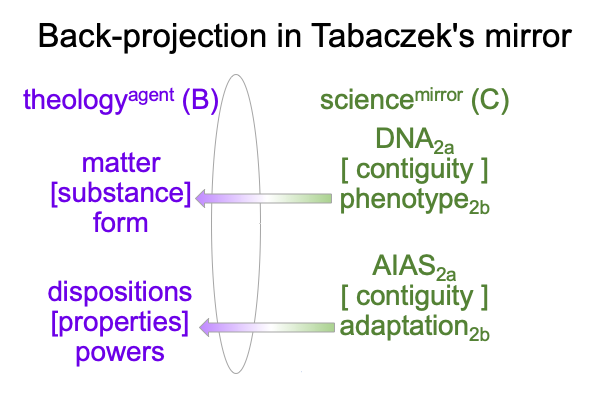
Does phenotype back-project into substance?
Does adaptation back-project into properties?
Uh-oh. Is this argument going to get even more complicated?
0687 In section 1.4, Tabaczek discusses Aristotle’s suggestion that matter tends to be actualized by more perfect forms, resulting in a hierarchy… or maybe… a gradation… in both non-living and living hylomorphes.
For example, interstellar matter is less “perfect” than a solar system. Bacteria are less “perfect” than eukaryotic cells. So, the word, “perfect”, does not mean, “flawless”, it means… um… more substantial. The hylomorphe packs more into the contiguity of [substance]. At the extreme, the most perfect being is the one that possesses the most substantial [substance].
0688 Perfection associates to final causality. A perfect tool is the one that is most useful. If the substance is [use], then perfection is in the fullness of its [use]. But, a tool does not use itself. An artisan [uses] a tool. So, a tool is one real element in a hylomorphe whose substance is [use]. The other real element is artisan.
With this final causality in mind, when I look at phenotype2b as matter [substance] form and consider Aristotle’s suggestion, then, I suspect that the phenotype2b tends toward a greater and greater substance.
0689 The question is, “What is this substance?”
Well, if DNA2a is like a cause and phenotype2b is like an effect, then I suspect that the metaphysical [substance] reflects a contiguity between cause and effect, which must correspond to the genome1b contextualized by body development3b.
In other words, for DNA2a [contiguity] phenotype2a, the contiguity should be [body development3b: genome1b].
This suspicion allows me to appreciate how bacteria are less “perfect” than eukaryotic cells. The actuality of bacteria (more or less) coincides with a content-level nested form. The actuality of eukaryotic cells may initially coincide with a content-level nested form, but as soon as they specialize to generate a tissue, another level appears. A tissue situates specialized cells. Then an organ situates a tissue, adding another level. Systems situate organs. Finally, a body serves as a level that puts all the lower levels into perspective.
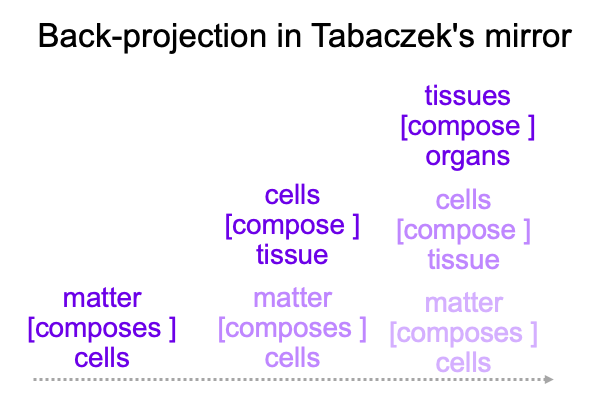
0690 The “perfection” of matter [substance] form for the phenotype2b makes me think that this perfection points to another substance, [body development3b: genotype1b].
At the same time, [body development3b: genotype1b] points back to [the contiguity between matter and form].
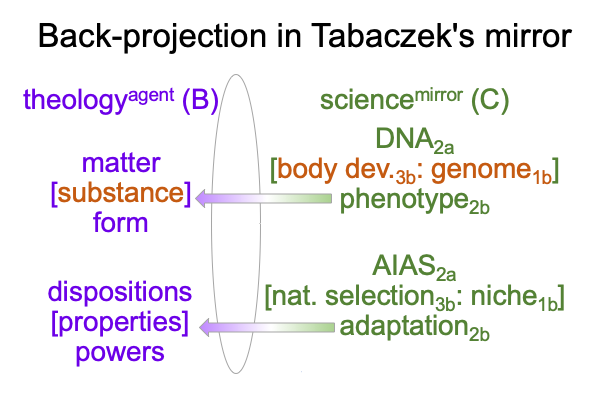
The associations make me wonder.
How does the Tabaczek’s metaphysical configuration of a living thing as primary matter [… ] substantial form (B1) reflect in the mirror of science (C2)?
Plus, if a scienceagent (A3) looks into sciencemirror (C1) can he (A3) ideate Tabaczek’s metaphysical configuration of primary matter [ ] substantial form (B1)?
0691 Here is idea that is even more confounding.
What if the perfection of matter [substance] form for the phenotype2b also arises from perfection of [natural selection3b: niche1b]?
Oh no! Who can imagine that!
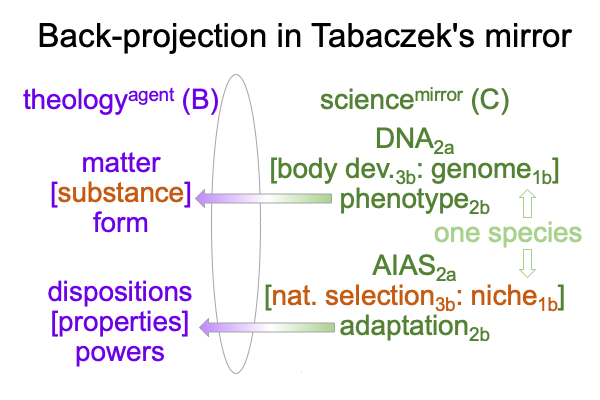
This implies that each additional level in matter [substance] form also “perfects” a lineage in terms of natural selection3binto a niche1b. If it does not, then extinction follows.
0692 Of course, this raises the possibility that the perfection of [properties] includes the perfection both [body development3b: genome1b] and [natural selection3b: niche1b].
No wonder biologists confound phenotype and adaptation.
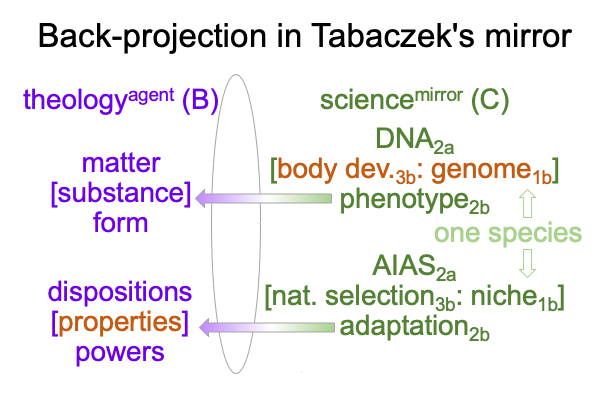
Theologians confound substance and properties.
